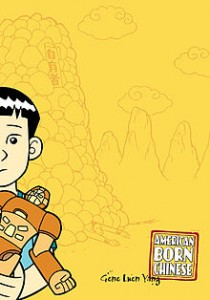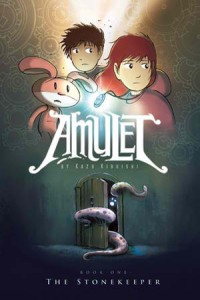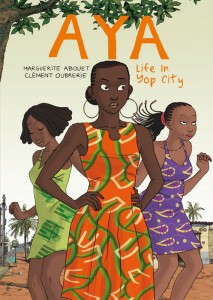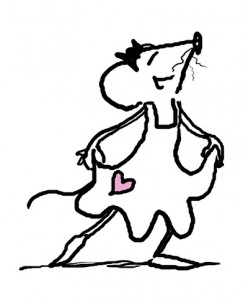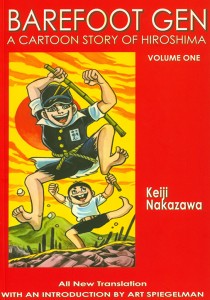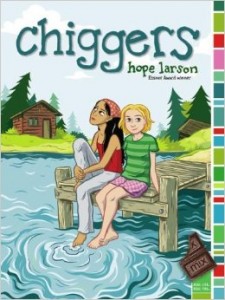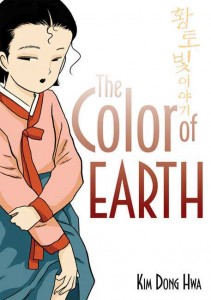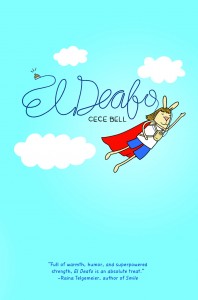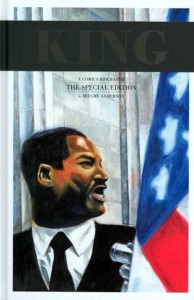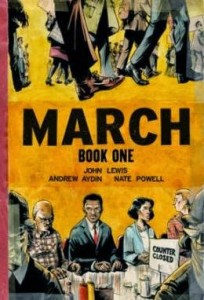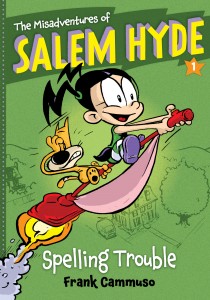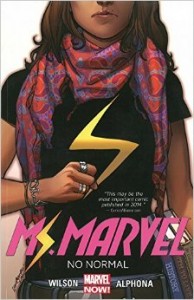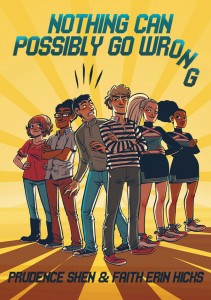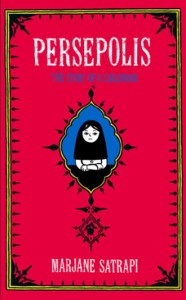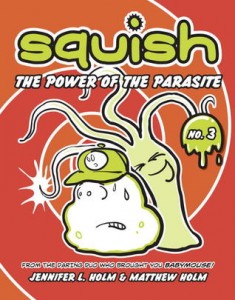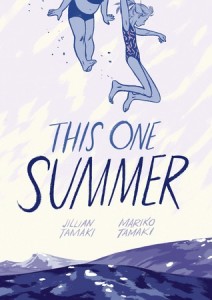Books aren’t just challenged and banned in libraries — increasingly, CBLDF has had to protect books on school reading lists and in classrooms! As we celebrate Banned Books Week, let’s take a look at some comics that make great classroom tools!
Using Graphic Novels in Education is an ongoing feature from CBLDF from Dr. Meryl Jaffe that is designed to allay confusion around the content of graphic novels and to help parents and teachers raise readers. In this column, we examine graphic novels, including those that have been targeted by censors, and provide teaching and discussion suggestions for the use of such books in classrooms. Books are added to the series semimonthly, so visit cbldf.org for updates.
1. Amelia Rules! by Jimmy Gownley
Jimmy Gownley’s Amelia Rules! is a New York Times bestseller. It has been nominated for 13 Eisner Awards (four nominations in 2008 alone), has been nominated for five Harvey Awards, and was a short list finalist for the Howard E. Day Prize in 2002. In 2007, Volume 3: Superheroes won the Cybil Award for best graphic novel for readers aged 12 and under. In 2008, Gownley won the Pennsylvania Library Association One Book Award, and in 2012, Volume 8: Her Permanent Record became the first Amelia Rules! book to make the New York Times bestseller list. Read the full post
• Use Amelia Rules! to teach about growing up, divorce, bullies, and overcoming challenges.
2. American Born Chinese by Gene Luen Yang
American Born Chinese is a 2006 National Book Award Honor Book for Young People’s literature, the 2007 winner of the Michael L. Printz Award honoring literary excellence in Young Adult literature, the winner of the 2007 Eisner Award for Best Graphic Album, and a 2007 Bank Street Best Children’s Book of the Year. In this work, creator Gene LuenYang skillfully weaves three seemingly independent stories of Chinese folklore, a teenager’s need to fit in, and adolescents’ balancing of their Chinese American heritage. Read the full post
• Use American Born Chinese to teach coming of age, finding oneself, and transitioning friendships and to teach about immigrant experiences in the United States.
3. Amulet by Kazu Kibuishi
Kazu Kibuishi’s Amulet is an award-winning graphic novel series about Emily and her brother Navin who, through extenuating circumstances, find themselves battling for the freedom of a parallel world and face mounting dangers with new-found friends.Emily and Navin move into their great-grandfather’s country house outside a town called Norlen after their father’s death. While the locals believe the house is haunted, Emily and Navin’s mom, Karen, has no choice but to fix up the old house and move in. Times have been hard without their dad, and the home is all they can afford. While cleaning the cobwebs and dust, Emily discovers a locket — the Amulet — and Karen, Emily, and Navin are transported into an alternate world through a small door in the basement. They soon discover that they’re descended from a line of Stonekeepers, people charged with protecting the alien world. They also find shortly after their arrival that something is terribly wrong. Read the full post
• Use Amulet to teach about growing up, overcoming challenges, and the importance of teamwork.
4. Astronaut Academy by Dave Roman
Astronaut Academy is a two-volume series about friendship, rivalries, diversity, teamwork, growing up, and the pleasures and pains of boarding school — in space. It is chalk-full of dinosaur cars, robots, magical elves, pandas, bunnies sports, love, bold statements, puns, cuteness, and evil. His story centers around life at a futuristic boarding school in space, and Roman packs so many references to both kid and adult movies, books, and games that these books, while geared for grades 4-8, can be enjoyed by kids of all ages. Read the full post
• Use Astronaut Academy to teach coming of age, finding oneself, and transitioning friendships and to support science instruction (physical and earth sciences).
5. Aya: Life in Yop City by Marguerite Abouet and Clement Oubrerie
Aya: Life in Yop City by Marguerite Abouet and Clement Oubrerie is loosely based on Abouet’s life and centers around 19-year old Aya, her friends, and their families in the Ivory Coast working class suburb of Abidjan in the 1970s. Aya was the winner of the Best First Album award at the Angouleme International Comics Festival, the Children’s Africana Book Award, and the Glyph Award. It was also nominated for the Quill Award, YALSA’s Great Graphic Novels, and the Eisner Award. It has also been included on best of lists from The Washington Post, Booklist, Publishers Weekly, and School Library Journal. It has been adapted into a film, Aya of Yop City (produced by Joann Sfar and Antoine Delesvaux). Read the full post
• Use Aya during Women’s History Month and to teach about other cultures.
6. Babymouse by Jennifer L. Holm and Matthew Holm
Jennifer L. Holm and Matthew Holm’s Babymouse is an award-winning graphic novel series that showcases the trials and tribulations of elementary school students and teachers, as seen through the eyes of Babymouse, as spunky, lovable mouse who wrestles with popularity, quirky lockers, competition — in the school band, school play, math Olympics, and even the best birthday party ever — and more. The series has won multiple Children’s Choice awards, the 2006 Gryphon Award, the 2006 ALA Notable Children’s Book Award, the 2006 New York Book Show Award. Read the full post
• Use Babymouse to teach about responsibility and overcoming challenges presented in an elementary school setting.
7. Bad Girls by Jane Yolen and Heidi Stemple
Bad Girls: Sirens, Jezebels, Murderesses, Thieves and Other Female Villains, by Jane Yolen and Heidi Stemple, illustrated by Rebecca Guay, incorporates both prose and illustration to put the deeds of 26 women — who were both famous and infamous — in perspective. (Recommended for middle school readers.) Read the full post
• Use Bad Girls during Women’s History Month (March) and to support history lessons.
8. Barefoot Gen by Keiji Nakazawa
Barefoot Gen by Keiji Nakazawa, translated by Project Gen (Last Gasp of San Francisco, 2004) is considered one of the most important anti-war manga ever written. The series focuses on the atomic bombing of Hiroshima and the aftermath of the Pacific War. Barefoot Gen has been repeatedly banned in its home country of Japan, but remains one of the most read manga in the world. Read the full post
• Use Barefoot Gen to teach about war, regime change, and a first-person perspective on living through upheaval; to teach about other cultures; and to support history instruction.
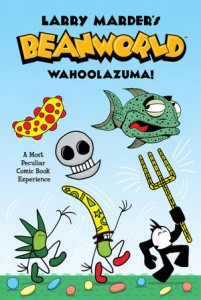
9. Beanworld by Larry Marder
Larry Marder gives you everything you’re going to need to navigate through Beanworld in the first few pages. He introduces you to the characters in, under, around, and traveling through Beanworld. It is a wonderful story about the forces and cycles of life, about responsibilities, about learning, and about growing. It’s about friendships and love. It’s about rivalries, creativity and balance. From Marder’s use of language, wordplay, slang and puns to his play on cultures and life and his simply drawn but far from simple images, it’s pure fun. Read the full post
• Use Beanworld to teach coming of age and life’s transitions, to support science instruction (life sciences, biology, botany) and to support art history instruction (modern and contemporary art).
10. Boxers & Saints by Gene Luen Yang
Gene Luen Yang’s Boxers & Saints revisits the Chinese Boxer Rebellion (1899-1900), sensitively and evenhandedly relating Chinese peasants’ perspectives from each side of the conflict. Boxerstells the story of the illiterate peasants tired of being hungry, tired of failing farms, and tired of Chinese Christian ruffians who would steal, cheat, and beat them while under Western protection. Saints tells the story of a peasant girl, who is shunned by her family but finds compassion and belonging with Christian converts. Read the full post
• Use Boxers & Saints to teach about war, regime change, and a first-person perspective on living through upheaval; to teach about other cultures; and to support history instruction.
11. Chiggers by Hope Larson
Hope Larson’s Chiggers is graphic novel that takes an honest look at the timeless ritual of summer camp as seen and experienced first-hand by Abby, a young teen attending her last year as a camper at sleep-away camp. Chiggers is a Junior Library Guild Selection and YALSA Great Graphic Novel for Teens Nominee. It follows Abby from the moment her parents rush her out of the house and drive her through country highways and hills to get her to camp before any other campers arrive and concludes when her parents are the first car in line on the last day of camp to take her home. It’s a story about friendship, fitting in, love, and loyalty, and it interweaves realities and fantasies of summer life. Read the full post
• Use Chiggers to teach coming of age and life’s transitions.
12. The Color of Earth Trilogy by Kim Dong Hwa
Kim Dong Hwa is a widely popular Korean comic artist. In the Color of Earth Trilogy, Dong Hwa tenderly tells the story of his mother’s growth into womanhood, as he imagined it might have been. This story is an incredible blend of prose, poetry, and penciled art. It is a story about young Ehwa’s growing curiosity about sex, puberty, and relationships. Based on Ehwa’s observations and interactions with friends, nature, and the villagers around her, she has wonderfully frank discussions with her mother, who tactfully and sensitively opens the world up for Ehwa. Read the full post
• Use The Color of Earth to teach coming of age and life’s transitions, to teach about other cultures, and to support social science instruction.
13. Drama by Raina Telgemeier
Raina Telgemeier’s Drama is a fictional story about seventh-grader Callie, who, like many kids her age, wrestles with a pesky, snooping little brother while navigating middle school friendships and crushes. The interesting thing about Callie is her passion around being on the Drama Club’s tech crew and interacting with her friends in the club. What makes this book so special though, is its message to young girls. Specifically, what makes Callie happiest is not being cool or popular or even winning “the boy.” Instead, it’s working hard on her set ideas, becoming the best stage manager ever of the Drama Club, and refining her voice, her vision, and her skills within that role. Read the full post
• Use Drama to teach coming of age and life’s transitions, finding oneself, and transitioning friendships in a school setting.
14. El Deafo by Cece Bell
Cece Bell’s El Deafo, a 2015 Newbery Honor Book has also received starred reviews from Kirkus Reviews and Publishers Weekly. El Deafo’s Newbery Honor “for outstanding contribution to children’s literature” is the first given to a graphic novel. In this graphic memoir, Cece Bell discusses with humor and honesty the challenges she faced as young girl after losing her hearing to illness. No one likes being different, and having to wear a bulky hearing aid strapped to her chest certainly didn’t help. Reading El Deafo, we experience what it is like living with severe to profound hearing loss, we see how lonely it can be when communication is difficult, and at the same time we realize that all of us are similar in some ways and different in others. The key is finding the inner strength to embrace our weaknesses and differences, and becoming stronger because of them. Read the full post
• Use El Deafo to teach about disabilities, overcoming physical challenges, and learning to embrace and celebrate difference.
15. I Kill Giants by Joe Kelly and JM Ken Niimura
I Kill Giants, by Joe Kelly and JM Ken Niimura, won the IGN Best of 2008, was voted one of the 10 Best Comics of 2009 by New York magazine’s Dan Kois; was a YALSA (Young Adult Library Association) 2010 Top Ten Great Graphic Novel for Teens, and won the Gold Award at the 5th International Manga Award I 2012. Through the prose and art of I Kill Giants, Joe Kelly and JM Ken Niimura provide a timeless, honest rendering of a child’s reaction to critical illness as eleven-year-old Barbara struggles to face an untimely loss, first through escapism and then gradually through acceptance. With Kelly’s insightful text and Niimura’s powerful images, we feel Barbara’s pains and struggles as she faces life’s challenges. Read the full post
• Use I Kill Giants to teach about coping with grief and loss, bullying, developing friendships, and overcoming challenges.
16. King by Ho Che Anderson
King by Ho Che Anderson (Fantagraphics, 1993; reprint edition 2010) is a highly acclaimed award-winning biography integrates interviews, narrative, sketches, illustrations, photographs and collages as it pieces together an honest look at the life, times, tragedies, and triumphs of Martin Luther King Jr. For King, Anderson won the Harvey Awards for Best New Talent (1991); Best Graphic Album (1993); and Parents’ Choice Award (1995). Read the full post
• Use King for Black History Month (February), teaching the Civil Rights Movement, and addressing racism.
17. March: Book One by John Lewis, Andrew Aydin, and Nate Powell
March: Book One begins the trilogy of Representative John Lewis’s graphic novel memoir, co-written with his aide Andrew Aydin and illustrated by Nate Powell. It is a critically acclaimed best-seller that received the 2013 Coretta Scott King Honor Book Award by the American Library Association and has been named one of the best books of 2013 by USA Today, The Washington Post, Publishers Weekly, Library Journal, School Library Journal, Kirkus Reviews, The Horn Book, ComicsAlliance, and others. Read the full post
• Use March: Book One for Black History Month (February), teaching the Civil Rights Movement, and addressing racism.

18. March: Book Two by John Lewis, Andrew Aydin, and Nate Powell
March: Book Two is the second volume of Representative John Lewis’s graphic novel memoire, co-written with his aide Andrew Aydin and illustrated by Nate Powell. March: Book Two details the real-life heroes of the 1960s, from the Civil Rights leaders of SNCC and the SCLC to the black and white protesters who risked life and limb for what was right. In Book Two, Lewis’s story continues with the events that took place on November 10, 1960, in Nashville, Tennessee, as “…our young organization had successfully ended segregation at the lunch counters downtown and turned its attention to fast food restaurants and cafeterias using the same strategy.” It then continues with events that took place in the South between 1960 -1963, culminating with the March on Washington on August 28, 1963. Read the full post
• Use March: Book Two for Black History Month (February), teaching the Civil Rights Movement, and addressing racism.
19. The Misadventures of Salem Hyde by Frank Cammuso
The Misadventures of Salem Hyde is a wonderful series about a strong-willed, spunky, impulsive young witch living in a non-witch community, who has a slight problem: Her spells tend to backfire. However, with the help of Whammy, her companion cat, she slowly deals with her “spelling” issues while boldly facing her nemesis Shelly and her teacher Mr. Fink (who “dislikes all kinds of kids but especially Salem”). The Misadventures of Salem Hyde received starred reviews from Kirkus Reviews and Publishers Weekly, and was named one of the Top 10 graphic novels of 2013 by The School Library Journal. These books contain fun-filled adventures and wordplay that make them an awesome read for kids of all ages (even though it is geared for 7- to 10-year-olds). Read the full post
• Use The Misadventures of Salem Hyde to teach about problem solving, developing friendships, and embracing difference.
20. Ms. Marvel by G. Willow Wilson and Adrian Alphona
Ms. Marvel: No Normal by G. Willow Wilson and Adrian Alphona features Kamala Khan, a 16-year-old Muslim girl from Jersey City, New Jersey who becomes the new Ms. Marvel. Wilson, Alphona, and the Marvel team create a modern twist offering fun and diversity for tween readers and beyond. Ms. Marvel is a finalist for the first Dwayne McDuffie Award for Diversity (nominees range from independent to mainstream comic books) and one of YALSA’s Top Ten 2015 Great Graphic Novels for Teens. It is also one of YALSA’s 2015 Quick Picks for Reluctant Young Adult Readers. Read the full post
• Use Ms. Marvel to teach coming of age, finding oneself, and transitioning friendships and to teach about immigrant experiences in the United States.

21. Nat Turner by Kyle Baker
Kyle Baker’s Nat Turner received the Glyph award for Best Artist, Best Cover, and for Best Story of the Year, 2006; the Eisner Award for Best Reality-Based Work, 2006; and the Harvey Award for Best Graphic Album — Previously Published, 2009. This work also received an Eisner Award nomination for Best Limited Series, 2006; and Harvey Award nominations for Best Writer, Best Artist and Best Single Issue or Story, 2009. Library Journal gave it a starred review noting, “Baker’s suspenseful and violent work documents the slave trade’s atrocities as no textbook can, with an emotional power approaching that of Maus.” Read the full post
• Use Nat Turner for Black History Month (February), teaching the Civil Rights Movement, and addressing racism.
22. Nothing Can Possibly Go Wrong by Prudence Shen and Faith Erin Hicks
Nothing Can Possibly Go Wrong is a graphic novel adapted and drawn by Faith Erin Hicks from the young adult novel Voted Most Likely by Prudence Shen. It’s full of unlikely friendships and nicely nuanced characters who bend and shatter stereotypes and expectations. The central characters are Charlie Nolen, captain of Hollow Ridge High School basketball team and his (best) friend Nate Harding, president of the robotics club. In a twist of fate, the robotics club and the cheerleaders are vying for student council funding. In an effort to win the funding, Charlie decides to run for student council president. The “Gestapo” cheerleaders decide to have Nate run against him with the hopes that they can manipulate Nate into funding their new outfits and not the robotics club. And while each group is convinced that their strategies are flawless, things don’t work out the way anyone had planned. Read the full post
• Use Nothing Can Possibly Go Wrong to teach coming of age and life’s transitions, overcoming stereotypes, and developing friendships in a school setting.
23. Persepolis by Marjane Satrapis
In Persepolis, author Marjane Satrapi tells of her experience growing up during the Iranian Revolution, the subsequent war between Iran and Iraq, and the rise of the Islamic Republic. Against these tumultuous events, readers get a glimpse of Satrapi’s teenage angst and her struggles to express herself under the burgeoning social repression of the new regime. Read the full post
• Use Persepolis to teach about war, regime change, and a first-person perspective on living through upheaval; to teach about other cultures, and to support history instruction.

24. Pretty in Ink by Trina Robbins
Pretty in Ink: North American Women Cartoonists 1896-2013, by Trina Robbins, is a more traditional biography that discusses the lives, times, struggles, and contributions of women in the world of cartoons and comics. (Recommend for high school and older.) Read the full post
• Use Pretty in Ink during Women’s History Month (March) and to support history and art history lessons.
25. SideScrollers by Matthew Loux
SideScrollers by Matthew Loux (ONI Press, 2008) is one of those books that are well written but that are not appropriate for all classrooms. And while named one of the Top Ten Great Graphic Novels for Teens in 2008 by the American Library Association, the book was pulled from a ninth grade summer reading list in Connecticut based on a compliant by a person who was not even a parent of a child in the school for “profanity and sexual references.” CBLDF sent a letter to Enfield Connecticut School District Superintendent, Dr. Jeffrey Schumann asking that it be returned to the summer reading list and “restore freedom of choice to the parents and children in their school.” Read the full post
• Use SideScrollers to teach coming of age and life’s transitions, overcoming stereotypes, and developing friendships in a school setting.
26. The Silence of Our Friends by Mark Long, Jim Demonakos, and Nate Powell
The Silence of Our Friends by Mark Long, Jim Demonakos and Nate Powell (First Second Books, 2012) is a semi-autobiographical story told from the perspective of Mark Long, as a boy. It centers around civil rights incidents covered by his father, a television reporter in Houston, Texas, in 1968, following the Texas Southern University student boycott after the Student Nonviolent Coordinating Committee (SNCC) was banned from campus. It ends with Dr. King’s assassination and the mourning of the larger Houston community as they marched in his memory. Read the full post
• Use The Silence of Our Friends for Black History Month (February), teaching the Civil Rights Movement, and addressing racism.
27. Smile by Raina Telgemeier
In this autobiographical coming-of-age graphic novel memoir, Raina Telgemeier ruminates with humor and honesty on the tumultuous challenges and perils of her teen years: from the trauma of falling one night on her way home from a Girl Scout meeting severely injuring her front teeth, to dealing with boys, earthquakes and the true meaning of friendship. Read the full post
• Use Smile to teach coming of age and life’s transitions, family life, developing friendships, and finding oneself.
28. Squish by Jennifer L. Holm and Matthew Holm
Jennifer L. Holm and Matthew Holm Squish is a comic book-loving, Twinkie-eating, blubbery, super-swell amoeba “kid” who wrestles with good and evil in life around him and learns about life’s responsibilities. He faces all sorts of challenges with his friends Pod, a nerdy, mooching amoeba who’s always working on some lay-brained science scheme to help him tame his world, and Peggy, a clueless, huge-hearted, super-sweet, happy-go-lucky loving paramecium. In the first four books, they face challenges in school, summer camp, soccer games, and much more. Read the full post
• Use Squish to teach about developing friendships and overcoming challenges and to support science instruction (life sciences).
29. Stuck in the Middle: Seventeen Comics from an UNPLEASANT Age, edited by Ariel Schrag
Stuck in the Middle: Seventeen Comics from an UNPLEASANT Age, edited by Ariel Schrag, is an anthology of comics by critically acclaimed cartoonists who take a bitingly honest look back at their “awkward” middle-school years, reflecting upon them with sensitivity and some humor. Many of the pieces, however lack resolution, making them unsettling — much like those teenage years themselves. While some may find this format haunting and less kid-friendly, the stories serve as outstanding opportunities to brainstorm and problem solve. Read the full post
• Use Stuck in the Middle to teach coming of age, life’s transitions, and overcoming challenges in a school setting.
30. This One Summer by Jillian Tamaki and Mariko Tamaki
This One Summer (First Second, 2014) by Jillian Tamaki and Mariko Tamakirocked the publishing, library, and literary world by being the first graphic novel to receive the Caldecott Honor for “Most Distinguished American Picture Book for Children” and the Printz Honor for “Excellence in Literature for Young Adults.” Told in warm prose and exquisite monochromatic blue images, This One Summer delicately balances the nostalgic power of summer traditions with the often harsh and intruding lessons of life. It embraces readers of all ages as two tween girls, local townie teens, and one set of parents all tangle in the delicate balances of friendships and relationships, grapple with the pains of growing up, deal with the torments of depression and of wanted and unwanted pregnancies, and cope with the heartbreaks and hopes of life. This One Summer has received outstanding praise and unprecedented honors for its stunning art and thoughtful, sensitive content. Read the full post
• Use This One Summer to teach coming of age, life’s transitions, maintaining friendships, and overcoming different challenges.
—
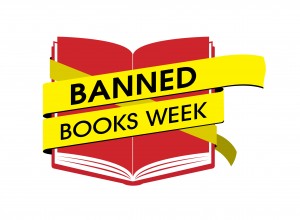 If you are planning a Banned Books Week event or display, it’s not too late to let us know about it! We’ll update this calendar of events throughout the week. Send the info about your event to betsy.gomez@cbldf.org!
If you are planning a Banned Books Week event or display, it’s not too late to let us know about it! We’ll update this calendar of events throughout the week. Send the info about your event to betsy.gomez@cbldf.org!
As you’re planning your events or developing your library and classroom curricula, be sure to check out these other valuable CBLDF resources:
- CBLDF Banned Books Week Handbook
- CBLDF Posters and Shelf Talkers
- CBLDF Comics Connector
- CBLDF Banned Books Week Gear Bundle
- 12 Challenged & Banned YA Graphic Novels for Banned Books Week 2015
- 28 Challenged and Banned Comics to Read During Banned Books Week 2015!
- 12 Challenged or Banned Summer Reading Books for Banned Books Week 2015!
- Raising A Reader: How Comics & Graphic Novels Can Help Your Kids Love to Read!
- Using Graphic Novels in Education
- Adding Graphic Novels to Your Library or Classroom Collection
- CBLDF Discussion Guides
- CBLDF Banned Comics Case Studies
- Comic Book Club Handbook
- CBLDF Presents: Manga
- Working With Libraries: A Handbook For Comics Creators
Banned Books Week is sponsored by the American Booksellers Association, American Booksellers for Free Expression, American Library Association, American Society of Journalists and Authors, Association of American Publishers, Comic Book Legal Defense Fund, Freedom to Read Foundation, National Association of College Stores, National Coalition Against Censorship, National Council of Teachers of English, PEN American Center, People for the American Way Foundation, and Project Censored.
Help support CBLDF’s important First Amendment work in 2015 by visiting the Rewards Zone, making a donation, or becoming a member of CBLDF!

